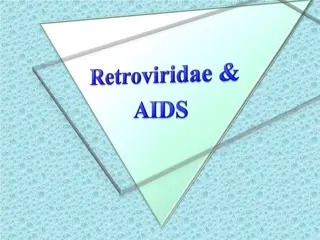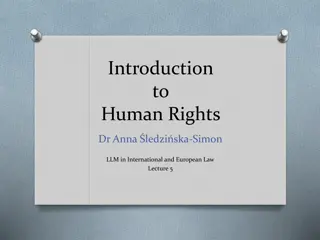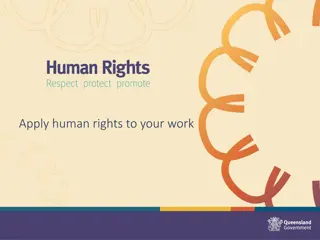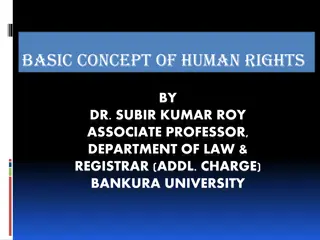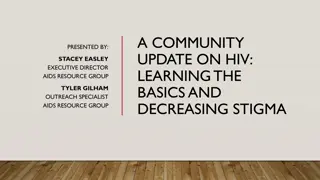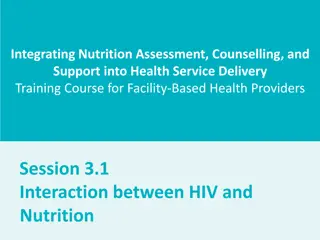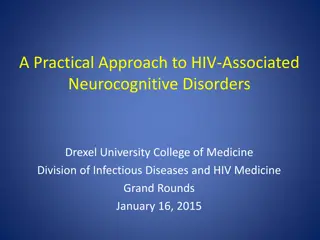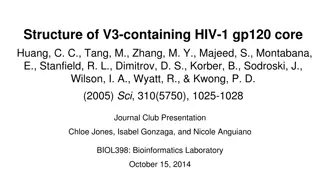Understanding the Intersection of HIV and Human Rights
Exploring the crucial connection between human rights and HIV response, this session delves into the fundamentals of a rights-based approach in supporting key populations at risk of HIV. Framing questions challenge misconceptions and emphasize the universal applicability of human rights, emphasizing the role of accountability and protection in promoting health equity.
Download Presentation

Please find below an Image/Link to download the presentation.
The content on the website is provided AS IS for your information and personal use only. It may not be sold, licensed, or shared on other websites without obtaining consent from the author. Download presentation by click this link. If you encounter any issues during the download, it is possible that the publisher has removed the file from their server.
E N D
Presentation Transcript
Module 1: Key elements of programming with key populations Session 1.5: HIV and human rights In-Reach Online Training | Increasing support and partnerships with key populations at risk of HIV
Introduction Human rights are at the core of the United Nations mission, and they are also the core of an effective approach to preventing and treating HIV, viral hepatitis and sexually transmitted infections. Only if the right to the highest attainable standard of health is realised for key populations can the HIV epidemic be ended. The critical enablers discussed in Session 1.4 are grounded in human rights. This session explores how a rights-based approach is essential to an effective HIV response. SESSION 1.5 | INTRODUCTION UNITED NATIONS DEVELOPMENT PROGRAMME
Session 1.5: HIV and human rights Questions to frame this session What is a rights-based approach? Elements of a rights-based approach Take-home messages Session review questions Further information and resources UNITED NATIONS DEVELOPMENT PROGRAMME
Framing questions 1. The human rights approach in HIV supports people to demand their rights. 2. The right to be free from violence has no relevance for HIV prevention. SESSION 1.5 | QUESTIONS TO FRAME THIS SESSION UNITED NATIONS DEVELOPMENT PROGRAMME
Framing questions 3. Reminding governments that their human rights obligations cover all citizens can help them see the importance of protecting key populations. 4. UN staff have no obligation to protect the human rights of people who are criminalised by their countries. SESSION 1.5 | QUESTIONS TO FRAME THIS SESSION UNITED NATIONS DEVELOPMENT PROGRAMME
Framing questions: responses 1. Correct. Key populations have the same human rights as everyone else, and learning about these rights, and holding decision-makers accountable for ensuring them, is fundamental to a human-rights approach. 2. Incorrect. Violence and the fear of violence prevent people from key populations from accessing programmes and services for HIV prevention. 3. Correct. Human rights are universal and apply even to people who are subject to social or legal discrimination. 4. Incorrect. UN staff are obligated to protect and advocate for the human rights of all people, regardless of their legal status. SESSION 1.5 | QUESTIONS TO FRAME THIS SESSION UNITED NATIONS DEVELOPMENT PROGRAMME
Session 1.5: HIV and human rights Questions to frame this session What is a rights-based approach? Elements of a rights-based approach Take-home messages Session review questions Further information and resources UNITED NATIONS DEVELOPMENT PROGRAMME
Human rights are at the core of commitments by UNAIDS and governments [UNAIDS] will mobilise political will to reduce inequalities, increase access to HIV services, catalyse action on societal enablers, including championing human rights and gender equality in the context of HIV. UNAIDS 2022-2026 Unified Budgets, Results and Accountability Framework A human rights-based approach is essential to create enabling environments for successful HIV responses and to affirm the dignity of people living with, or vulnerable to, HIV. Global AIDS Strategy 2021-2026 [Governments commit to] eliminating HIV-related stigma and discrimination and to respecting, protecting and fulfilling the human rights of people living with, at risk of and affected by HIV. 2021 Political Declaration on HIV and AIDS SESSION 1.5 | WHAT IS A RIGHTS-BASED APPROACH? UNITED NATIONS DEVELOPMENT PROGRAMME
What is a rights-based approach to HIV and HIV prevention? Taking a human rights-based approach to HIV with key populations means: Supporting governments to realise the rights of those most affected by HIV Supporting people to take up or demand their rights Ensuring that the HIV response addresses the vulnerabilities and needs of those most affected, including key populations Ensuring that the HIV response is non-discriminatory, inclusive, participatory, and accountable (human rights principles for all) SESSION 1.5 | WHAT IS A RIGHTS-BASED APPROACH? UNITED NATIONS DEVELOPMENT PROGRAMME
Which human rights are we talking about? The rights necessary to enable people to avoid infection the right to prevention include rights to information, education, health and privacy; gender equality and freedom from violence; the rights of refugees and migrants; and non-discrimination. The rights necessary to live well with HIV the right to treatment, care and support include rights to non-discrimination, health, employment, housing and social security; gender equality and freedom from violence. SESSION 1.5 | WHAT IS A RIGHTS-BASED APPROACH? UNITED NATIONS DEVELOPMENT PROGRAMME
Why is action on rights necessary? It s the right thing to do States are legally obligated to do it It is part of UN staff obligations (UN Charter, Standards of Conduct for the International Civil Service) A rights-based approach makes the HIV response more effective The Secretary-General reminds us in his Call to Action on Human Rights that as UN staff, we are obliged to work with all groups and to reduce discrimination and promote enabling environments for key populations. Click on the image above to view the video or see here for the YouTube Link. SESSION 1.5 | WHAT IS A RIGHTS-BASED APPROACH? UNITED NATIONS DEVELOPMENT PROGRAMME
What does a rights-based approach to HIV do? Changes discourse on HIV prevention and treatment from discretionary to entitlement Addresses issues of social justice and structural factors Helps make governments accountable Empowers individuals and communities Makes sure the most marginalised are not left out SESSION 1.5 | WHAT IS A RIGHTS-BASED APPROACH? UNITED NATIONS DEVELOPMENT PROGRAMME
What does it mean practically? We have to be concerned with process and content We have to work for the most vulnerable and most affected We have to take on political challenges and controversial issues We have to change the nature and coverage of programmatic responses Efforts to anchor HIV responses in human rights principles and approaches can only be achieved through strong political leadership and the active engagement and leadership of community-led responses that are adequately resourced to advocate for, monitor and implement rights- based responses. Global AIDS Strategy 2021-2026 SESSION 1.5 | WHAT IS A RIGHTS-BASED APPROACH? UNITED NATIONS DEVELOPMENT PROGRAMME
Session 1.5: HIV and human rights Questions to frame this session What is a rights-based approach? Elements of a rights-based approach Take-home messages Session review questions Further information and resources UNITED NATIONS DEVELOPMENT PROGRAMME
Foundations of a rights-based approach To be successful, a rights-based approach requires certain components and principles: Equality and non-discrimination in programmatic expenditure and applications Participation of those affected informed, active, free and meaningful participation of key populations in HIV-related decision-making processes Accountability mechanisms for governments, intergovernmental organisations, donors and the private sector (e.g. UNGASS reporting and the Three Ones) Monitoring and evaluation data disaggregated by sex, age, marital status, rural/urban status, economic status, language, ethnicity, participation SESSION 1.5 | ELEMENTS OF A RIGHTS-BASED APPROACH UNITED NATIONS DEVELOPMENT PROGRAMME
Types of rights-based programmes Programmes to empower e.g. reform of punitive and discriminatory laws and policies, legal aid, human rights education, social mobilisation Programmes that further human rights outcomes e.g. protection from violence and sexual violence, gender equality, education, information, health, employment, access to scientific progress Programmes that focus on the most vulnerable and marginalised including key populations, young people and people living with HIV e.g. reform of public health and law enforcement practices to ensure they support rather than impede the HIV response; ending of compulsory testing, treatment or detention SESSION 1.5 | ELEMENTS OF A RIGHTS-BASED APPROACH UNITED NATIONS DEVELOPMENT PROGRAMME
Questions to ask about a rights-based approach Framework for analysis of the response: Are governments meeting human rights responsibilities in their HIV response? Platform for advocacy: How can we use human rights arguments with government and civil society? Programmatic and political obligations: Are programmes sufficiently addressing those most affected, and challenging the inequities and power imbalances that create vulnerability to HIV? Image: Pepetsa Fumo is the Founder of TRANSformar.moz, an organisation dedicated to advancing the human rights, recognition, inclusion and respect of transgender persons in Mozambique, and a partner of UNDP s Linking Policy to Programming project. SESSION 1.5 | ELEMENTS OF A RIGHTS-BASED APPROACH UNITED NATIONS DEVELOPMENT PROGRAMME
Legal approaches to supporting equity and rights in the HIV response Revise national laws to allow the full use of the flexibilities under the TRIPS Agreement in national laws Adopt anti-counterfeit legislation to control counterfeit medications and other medical goods Train and support national parliamentarians Establish legal clinics and train paralegals on HIV-related legal issues Campaign for increasing legal literacy and facilitate access to justice Train prison personnel on the prevention and health-care needs and human rights of detainees living with HIV or at risk of HIV SESSION 1.5 | ELEMENTS OF A RIGHTS-BASED APPROACH UNITED NATIONS DEVELOPMENT PROGRAMME
Session 1.5: HIV and human rights Questions to frame this session What is a rights-based approach? Elements of a rights-based approach Take-home messages Session review questions Further information and resources UNITED NATIONS DEVELOPMENT PROGRAMME
Take-home messages A rights-based approach to policy and programming for HIV is a commitment of the UN and of Member states The human rights of key populations in the HIV epidemic extend beyond health to privacy, education, non-discrimination, employment, housing, gender equality and freedom from violence A rights-based approach addresses critical enablers, fosters community empowerment and holds governments accountable UN organisations can advocate for and support legal reforms to realise the human rights of key populations SESSION 1.5 | TAKE-HOME MESSAGES UNITED NATIONS DEVELOPMENT PROGRAMME
Session 1.5: HIV and human rights Questions to frame this session What is a rights-based approach? Elements of a rights-based approach Take-home messages Session review questions Further information and resources UNITED NATIONS DEVELOPMENT PROGRAMME
Session 1.5: HIV and human rights Questions to frame this session What is a rights-based approach? Elements of a rights-based approach Take-home messages Session review questions Further information and resources UNITED NATIONS DEVELOPMENT PROGRAMME
Additional resources (1) The website of the Office of the High Commissioner on Human Rights contains information on human rights instruments to better understand the UN s focus on ensuring inclusion and dignity for all. IN DANGER: UNAIDS Global AIDS Update 2022 (UNAIDS, 2022) Consolidated Guidelines on HIV, Viral Hepatitis and STI Diagnosis, Prevention, Treatment and Care for Key Populations (WHO, 2022) World AIDS Day Report: Unequal, Unprepared, Under Threat (UNAIDS, 2021) Implementing and Scaling up Programmes to Remove Human Rights Related Barriers to HIV Services (The Global fund, Frontline AIDS, 2020) HIV and Stigma and Discrimination: Human rights Fact Sheet Series (UNAIDS, 2021) SESSION 1.5 | FURTHER INFORMATION AND RESOURCES UNITED NATIONS DEVELOPMENT PROGRAMME
Additional resources (1) UNAIDS Guidance Note on HIV and Sex Work (UNAIDS, 2012) Fast-Track and Human Rights (UNAIDS, 2017) International Guidelines on Human Rights and Drug Policy (UNDP, 2020) Risks, Rights and health: Report of the Global Commission on HIV and the Law (UNDP, 2012) Resources on critical enablers are listed at the end of Module 1, Session 1.4 SESSION 1.5 | FURTHER INFORMATION AND RESOURCES UNITED NATIONS DEVELOPMENT PROGRAMME




